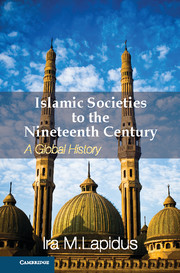Book contents
- Frontmatter
- Contents
- List of Illustrations
- List of Figures
- List of Maps
- List of Tables
- Preface
- Acknowledgments
- Acknowledgments to the first edition of A History of Islamic Societies
- Acknowledgments to the second edition of A History of Islamic Societies
- Publisher's Preface
- Introduction to Islamic Societies
- Part I The Beginnings of Islamic Civilizations
- The Middle East from c. 600 TO c. 1000
- The Preaching of Islam
- Chapter 2 Historians and the Sources
- Chapter 3 Arabia
- Chapter 4 Muhammad: Preaching, Community, and State Formation
- The Arab-Muslim Imperium (632–945)
- Cosmopolitan Islam: The Islam of The Imperial Elite
- Urban Islam: The Islam of Scholars and Holy Men
- Women, Families, and Communities
- Part II From Islamic Community to Islamic Society
- Part III The Global Expansion of Islam from the Seventh to the Nineteenth Centuries
- Glossary
- Bibliography
- Annotated Bibliography from A History of Islamic Societies, 2nd Edition
- Index
- References
Chapter 4 - Muhammad: Preaching, Community, and State Formation
Published online by Cambridge University Press: 05 February 2013
- Frontmatter
- Contents
- List of Illustrations
- List of Figures
- List of Maps
- List of Tables
- Preface
- Acknowledgments
- Acknowledgments to the first edition of A History of Islamic Societies
- Acknowledgments to the second edition of A History of Islamic Societies
- Publisher's Preface
- Introduction to Islamic Societies
- Part I The Beginnings of Islamic Civilizations
- The Middle East from c. 600 TO c. 1000
- The Preaching of Islam
- Chapter 2 Historians and the Sources
- Chapter 3 Arabia
- Chapter 4 Muhammad: Preaching, Community, and State Formation
- The Arab-Muslim Imperium (632–945)
- Cosmopolitan Islam: The Islam of The Imperial Elite
- Urban Islam: The Islam of Scholars and Holy Men
- Women, Families, and Communities
- Part II From Islamic Community to Islamic Society
- Part III The Global Expansion of Islam from the Seventh to the Nineteenth Centuries
- Glossary
- Bibliography
- Annotated Bibliography from A History of Islamic Societies, 2nd Edition
- Index
- References
Summary
The Life of the Prophet
Prophecy is a rare phenomenon, and all the more extraordinary is the prophet whose influence permanently transforms the lives of his people and leaves as a legacy one of the world's great religions. Thus the life of Muhammad and the rise of Islam have to be understood in terms of both religious vision and worldly impact. In this chapter, I outline the Prophet's biography as reported in the earliest Muslim sources and review critical themes in the scholarly interpretation of Muhammad's life.
Compared with those of the founders of other great religions, the sources of our knowledge of the Prophet's life are abundant. The life of Muhammad is reported in sira (biographical narratives of the Prophet), maghazi (campaign and battle narratives of the early Muslim community), and hadith (narratives of the Prophet's words and deeds). They were first transmitted as quasi-oral, quasi-written materials, some of which can be traced back to the students of Muhammad's companions or the companions themselves. ʿAbdallah ibn Abi Bakr (d. 747–48 or 752–53) was the first to put them in chronological order. The earliest surviving biography, the sira of Ibn Ishaq (d. 768–69) dates to the middle of the eighth century. Ibn Ishaq located Muhammad in Near Eastern prophetic history and emphasized the religious and miraculous aspects of his life. Al-Waqidi (d. 822) highlighted the political and military dimensions of the early Muslim community. Ibn Hisham (d. 833–34) edited the work of Ibn Ishaq, leaving out biblical history from Adam to Abraham and poetry and stories in which the Prophet was not involved. Much of the material rejected by Ibn Hisham is found in the later work of al-Tabari and others.
- Type
- Chapter
- Information
- Islamic Societies to the Nineteenth CenturyA Global History, pp. 39 - 54Publisher: Cambridge University PressPrint publication year: 2012



